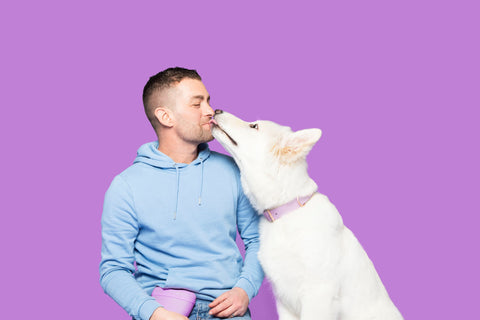Do dogs get IBS? Our vet Dr Scott Miller breaks it down for you

Do dogs get IBS? Our vet Dr Scott Miller breaks it down for you
Many of us humans know the discomfort of irritable bowel syndrome (IBS), with around 15% of the population suffering from the chronic condition. But have you wondered if your pet can suffer from IBS? Our vet Dr Scott Miller, shares whether or not dogs can get irritable bowel syndrome and what it may look like in dogs for those worried pet owners out there.
What is IBS in dogs?
Like humans, IBS is a condition that affects the digestive system in dogs, giving them an upset stomach. While it is an uncommon issue in dogs, any dog can be affected. Breed, sex and age do not change the chances of your pup getting IBS, so your small breed puppy has the same chances of having an IBS episode as a large breed senior dog. In dogs that suffer from irritable bowel syndrome, it can cause diarrhoea, constipation and vomiting due to irregular function of their intestinal muscles.
What causes irritable bowel syndrome in dogs?
There isn’t one definitive trigger for irritable bowel syndrome in dogs, as it can be set off by genetics or environmental stimulants like stress or food allergies. So, making sure your dog is getting the proper nutrition is key for their general health. A dog's IBS can also be triggered by bacterial infections or irritation in the bowel from obstructions in the intestines. To narrow down the cause, make sure to book an appointment with your vet.
What are the symptoms of IBS in dogs?
When it comes to the symptoms, you can notice physical and behavioural changes that may signify your dog is suffering. Not all of these symptoms are exclusive to IBS, though, making it harder for a vet to determine if your dog is experiencing the condition.
Top 10 IBS symptoms in dogs
- Diarrhoea
- Constipation
- Abdominal pain
- Vomiting
- Flatulence
- Loss of appetite
- Dehydration
- Weight loss
- Poor coat quality
Some behavioural changes you may notice when a dog is suffering from irritable bowel syndrome are that your dog may seem more emotionally sensitive than usual and have less energy, and want to rest more than usual.

Our dog behaviourist , Adem Fehmi, shares these tips to spot the signs of a sad dog and reduce the stressors in your environment for them.
“Dogs can become anxious, stressed and develop a low mood for a number of reasons. Some key factors can be a lack of exercise for their individual needs, a change in routine, a new environment that they are not used to, or even a trigger or event that has caused them to lose their confidence. Some dogs are prone to becoming stressed with even the slightest change to their usual day to day, whilst others may take change in their stride. Signs of stress, anxiety and low mood in dogs can include:
- A tucked up body and/or tail
- Cowering
- Ears pulled back
- Whale eye - where the whites of their eyes can be seen
- Panting or hyperventilating
- Shaking or trembling
- Actively trying to avoid something/someone/a place
- Generally being agitated
- Becoming reactive to people, dogs or the environment in general
- Reluctance to carry out their normal activities
- Reluctance to eat
- Inability to settle and relax
- Becoming withdrawn or quieter than usual
These are just a few signs to look out for. All dogs will behave slightly differently when they are stressed or have developed a low mood. It is unlikely that a dog would display all of these symptoms and it is important to observe your individual dog carefully and know their typically behaviour in order to ascertain if your dog may be anxious, stressed or is suffering from a low mood.”
Adem’s Top Tips to Reduce Stress, Anxiety and Low Mood:
1) Exercise your dog well and consistently.
This is beneficial for all dogs, but particularly if your dog is prone to suffering from stress, anxiety or a low mood in general. Constructively exercising your dog will help to drain some of your dog’s energy, energy that they might otherwise put into worrying and stressing at things out of their control. A well exercised dog is also more likely to settle and relax peacefully rather than one who is raring to go! Similar to the benefits that exercise has on us as humans, exercise has a positive effect on the mental wellbeing of our dogs and can help to keep them calm and well balanced.
2) Structure your dog’s day to include exercise, rest periods and playtime:
Just like us humans, dogs can and will get bored and need regularly mental and physical enrichment. Without this type of enrichment, stress and anxiety can be exacerbated. Daily use of play toys, food dispensing toys and training can assist here. We have a wide range of yummy treats and nutritional food items that you can use for these activities.
3) Create a calm environment for your dog to relax in.
Playing classical or soft music can help your dog to relax and can help to reduce stress. Classic FM is always a winner in my house! Music can also help to drown out any external noises that might otherwise cause your dog to worry and become stressed, contributing to a low mood. A nice comfortable and inviting bed can also help your dog to relax.
4) Set your dog up for success
If you know that a change of routine is coming that might cause your dog to feel stressed then start preparing them for this in advance. Introduce them to people, objects, experiences and so on that will be part of their new routine, even if this will only be the case for a short while. The more flexible and confident your dog is in general, the easier it will be for them to cope with any change, reducing the potential for stress, anxiety and low mood to affect your dog. Use tasty treats to positively reinforce calm, confident and accepting behaviour in new contexts.
5) Understand your dog’s triggers.
And take steps to work through these so that, in time, they are not stressful for your dog. We want our dogs to learn about the world in a positive light and become confident individuals within it. A certified behaviourist can help you to achieve this should you need some support.
How do you diagnose IBS in dogs?
IBS presents many of the same symptoms as other health conditions dogs may suffer from, so your vet would diagnose them through exclusion. This is where your vet will test for other illnesses to rule those out before declaring IBS. They will most likely conduct blood tests and faecal matter examinations to check for bacterial infections in the intestinal tract that may be giving your pooch an upset stomach.
How do you treat IBS in dogs?
As with humans, doggy IBS can lie dormant until it’s triggered and flares up, so treating it may be an ongoing affair. Your vet may prescribe your pup antispasmodic medications, which can help with their abdominal pain and discomfort.
They may also be prescribed anti-diarrhoea medication to help firm their stool, but dietary management and a swap to high-fibre dog food may also be suggested. This would firm up their stool as well as provide them with the proper nutrition they need to be a healthy, happy pup.
Your vet may suggest they are not fed rich foods – like the scraps off your plate - in order to let the medication and dog food they’re on work their course, as the richer foods may irritate their bowels further.
What if it's not IBS?
IBS can often be mistaken for Inflammatory Bowel Disease (IBD) in dogs as it is also a condition which affects a dog's intestines.
In dogs, IBD can be caused by an infection in the gut or a food allergy. It has some of the same symptoms as IBS, like vomiting and chronic diarrhoea, but it is tested for differently than IBS, as vets look for inflammatory cells through biopsies. The main difference between IBS and IBD is that IBS is mainly caused by stress related to a dog's environment or anxiety, whereas IBD has mainly physical causes that a vet can look for. If you suspect your dog is suffering from either, make sure to take them to the vet for a diagnosis.
Just remember that not all cases of doggy diarrhoea are a case of IBS as poo happens, and there can be many factors involved, but if you notice the other symptoms at home, make sure to book a trip to the vet and comfort your pet.
Share Article

Tummy Lovin' Care Fish Dry Dog Food - All Hounder
£9.00 - £64.99


